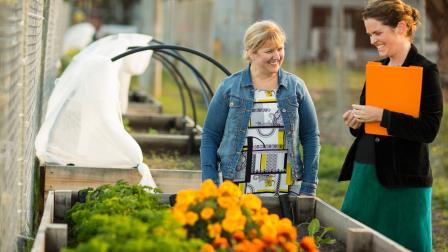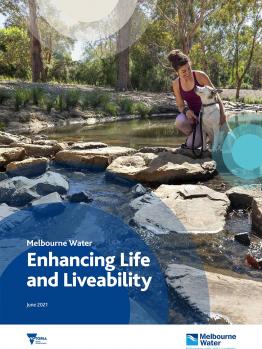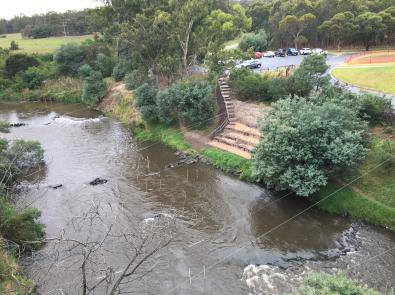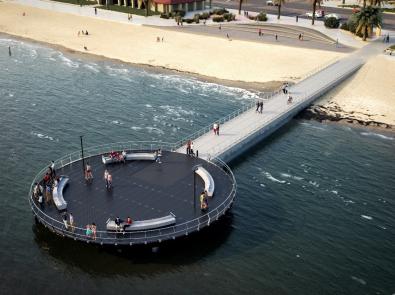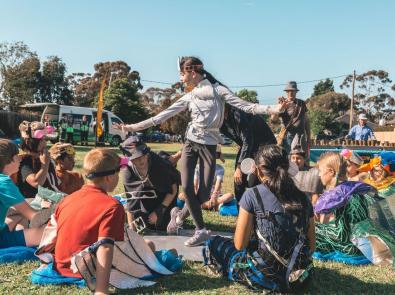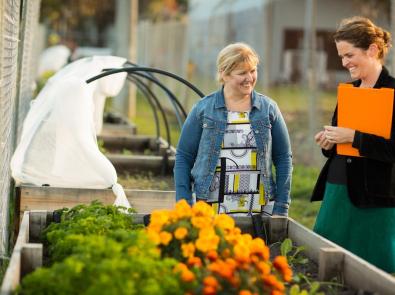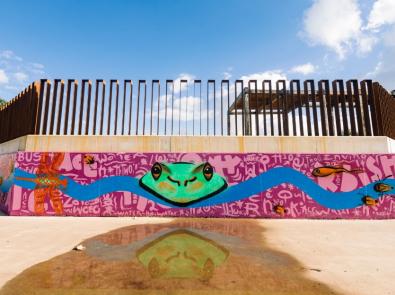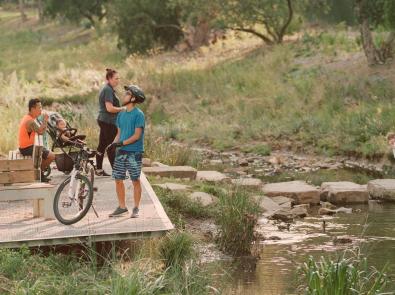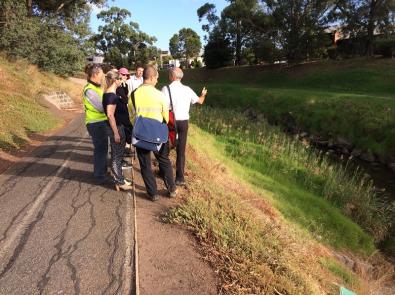Melbourne is consistently regarded as one of the world’s most liveable cities. We’re in a unique position to contribute to Melbourne’s treasured liveability through our assets, knowledge, connections and excellence in project delivery.
Enhancing life and liveability is our vision that guides everything we do. We believe this is about making life better, healthier, safer, more enjoyable and enriching for everyone through our work.
Our contribution to liveability
We aim to deliver our work in a way that realises multiple benefits for the community of greater Melbourne, and builds a lasting liveability legacy for future generations to enjoy.
We have long been delivering liveability outcomes through:
Public health
Providing clean water and reliable sanitation that people depend on
Public safety
Protecting communities from the impacts of floods, through flood management and drainage services delivered in partnership with local government, the State Emergency Service and other organisations
More recently, we have expanded our focus to enhance liveability through:
Active transport links
through shared paths along pipe tracks and creek corridors, Melbourne’s iconic network of parklands
Urban cooling
Planting to create shade along waterways and other open spaces
Recreation
Supporting healthy communities by enhancing passive and active spaces on land and on water
Sense of community
Creating diverse, equitable and inclusive places that celebrate our culture
Sense of place
Deliver places that connect communities to nature, each other and cultural heritage by providing access to our many beautiful waterways
Case studies
Browse the following selection of projects to see examples of our work in action.
For more case studies and information on our commitment to enhancing liveability, download our Liveability Brochure:
Interested in pursuing a partnership opportunity to deliver great liveability outcomes? Get in touch:
[email protected]
Active transport links
- Maribyrnong River parkland and pathways
-
Project partners: Maribyrnong and Moonee Valley City Councils
Aerial view of the Maribyrnong River. In partnership with Maribyrnong and Moonee Valley City Councils, we’re finalising plans to incorporate a lasting liveability legacy as part of a large-scale sewer upgrade.
The Maribyrnong River Main Sewer is reaching capacity due to population growth and more frequent extreme rainfall associated with climate change. We plan to divert sewage flows by installing a 1.2km underground gravity sewer which will cross the river via a new pipe bridge with pedestrian access, increasing local connectivity.
As part of the project:
- 15,000m2 of land along the river will become accessible to the community, providing much-needed open space for passive and active recreation in a densely urbanised part of Melbourne.
- A new 300m shared path will connect existing local path networks, creating a key link in the western active transport corridor.
- The new pipe bridge will incorporate a key active transport link, with a new inclusive access path designed to support bike, pedestrian, pram and wheelchair traffic.
- Local amenity and environmental values will be improved through removing weeds and revegetation, creating a peaceful place with high aesthetic value for the community to enjoy.
Works will commence in early 2022, with completion expected within two years.
For the latest information on this project, visit the Maribyrnong River Main sewer upgrade page.
- Bike trail – Carrum to Warburton
-
Completed: 2018
Project partners: VicRoadsWe worked closely with VicRoads on the business case and design of a ten-kilometre bike path linking the pre-existing Warburton and Eastlink trails. Three kilometres of this was built on a Melbourne Water pipe track in Croydon, with the entire trail now extending 90 kilometres from Carrum to Warburton – connecting the bay to country Victoria.
This case study highlights the benefits of a whole-of-government approach to planning and funding projects like these.
Learn more about building a shared pathway on our land.
Urban cooling
As the manager of over 33,000 hectares of land in Greater Melbourne, we’re doing our part to make Melbourne cooler and greener. For examples of how we’re working with councils and community groups to transform exposed parklands, paths and trails into enjoyable community spaces, see our urban cooling program.
Recreation
- Yarra River recreational paddling access – Templestowe
-
Completed: 2020
Project partners: Manningham City Council, Paddle VictoriaNew pathways and stairs at Westerfolds Park. In partnership with Manningham City Council and Paddle Victoria, we’ve completed works to improve canoe and kayak access to the Yarra River at Westerfolds Park, Templestowe.
The site has long been valued by the paddling community. It was identified as a priority location to improve access in the long-term vision of the Regional Paddle Sports Centre, and through community consultation to develop our 2018 ‘Improving access to the Yarra River project’ report.
New pathways and stairs have been built into the riverbank to improve safety and ease of access to this section of the river. A new viewing area was also created close to the slalom course which will improve spectator viewing during training and competition, as well as being a great feature for the broader community.
Read more about the project: New Yarra River pathway gives paddlers safe and direct access to the water
Sense of community
- Shakespeare Grove viewing platform – St Kilda
-
Project partners: Various
Artist's render of the viewing platform in St Kilda. When the Shakespeare Grove Main Drain Outlet at Melbourne’s beloved St Kilda beach came up for renewal, we embraced the opportunity for our capital improvement program to create a lasting liveability legacy through the innovative ‘Circle of Reflection’ viewing platform.
The unique and eye-catching platform will sit at the end of the renewed outlet, which fulfills the core purpose of seaweed deflection and safe and appropriate drainage. The design was selected from three options and refined through community and stakeholder consultation, resulting in a design supported and ‘owned’ by all involved.
The Circle of Reflection will become a valued destination point for Melburnians and tourists alike, allowing them to access, experience and enjoy the marine environment in a novel manner. The permeable platform surface will transmit the sights and sounds of wave flow, enabling a sensory-rich experience of the marine environment in a densely populated inner-city location. The modern curvilinear design incorporates a range of accessibility and safety features, including LED lighting to encourage night-time use, and curved bench seating to encourage extended visitation, reflection and enjoyment.
Construction commenced in 2021 and is expected to finish in early 2022.
For further information, refer to the Shakespeare Grove main drain outlet renewal project page.
- ‘Parktopia’ event at Chain of Parks – Coburg North
-
Completed: 2018
Project partners: City of Moreland, Pascoe Vale North Primary School, local artistsChildren’s performance to open the Parktopia event, showing the waterway’s importance to flora and fauna. We collaborated with City of Moreland on ‘Parktopia’, a community-led activation held at Linear Reserve at the northern end of the Chain of Parks – a project proposing to use our drainage land to connect several parks. The event identified future uses of the reserve for inclusion in Moreland’s masterplan, and followed community co-design workshops and a collaborative arts and performance educational program.
Led by local artists (Vanessa Chapple, Kate Kantor and Tanja Beer), the program worked with schoolchildren to explore the history and cultural heritage of the reserve, and unearth their creative ideas to reimagine the wonderful but underutilised open space.
Highlights of the Parktopia event included:
- a smoking ceremony for the whole community
- a representation of the now underground Merlynston Creek
- native vegetation likely to be present in the landscape
- history told through interpretive dance and storytelling
- a range of activities where children and visitors could interact with the local environment.
- Community gardens – Hope City Mission
-
Completed: 2016
Project partners: Hope City MissionCEO of Hope City MIssion with Melbourne Water staff. A linear strip of above-ground garden beds were built on a pipe track corridor behind the Hope City Mission distribution centre. The Mission will use the vegetables grown to help their clients understand how to use fresh produce and prepare healthy meals, as well as supplement the 200+ kilograms of fresh produce they distribute to the community every day.
Hope City Mission's emergency relief programs provide assessment-based Foodbank, financial assistance and advocacy, and life skills workshops to those in greatest need in the eastern metropolitan suburbs.
- Murals of platypus and frogs – Diamond Creek and Williams Landing
-
Completed: 2018
Project partners: Local artists, Truganina South Primary SchoolFrog mural painted by local students. We sponsored a mural by local students on an underpass along Diamond Creek in Eltham, helping to enhance the area’s amenity and educate the public about the impacts of litter in waterways.
A similar student mural was also sponsored at Williams Landing along the Greening the Pipeline project, featuring frogs that live in the surrounding waterways.
Read more about the project: New mural unveiled as part of Frog Census program
Sense of place
- Reimagining Your Creek Program
-
Project partners: Various
We’ve been working with our project partners, community representatives and residents to reimagine a number of creeks across Melbourne: transforming underground stormwater drains back into natural waterways and valued community spaces, where people can interact with nature in cooler, healthier environments.
New social infrastructure reconnects the community at Blind Creek (courtesy REALM studios). Current and completed projects include:
- Moonee Ponds Creek, Strathmore and Oak Park (commencing January 2022)
- Arnolds Creek, Melton West (completed)
- Blind Creek, Boronia (completed)
- Tarralla Creek, Croydon (nearly completed)
Each project was co-designed with the community and informed by local knowledge, values and priorities. This means that the people most likely to use the creek and its open space have influenced the designs to meet their needs and preferences.
In 2021, the program was awarded the AILA (Australian Institute of Landscape Architects) Victoria Award of Excellence for Infrastructure:
Reimagining Your Creek inverses the standard approach of considering the environment as a resource to be controlled and used by humans. The strategic thinking and strong concept has delivered a scalable and adaptable framework that has fostered a more equitable relationship between humans and the environment.
- AILAFor the latest information, refer to the Reimagining Your Creek program.
- Greening the Pipeline pilot park – Williams Landing
-
Completed: 2017
Project partners: Wyndham City Council, City West Water, VicRoads; jointly funded by the Victorian Government and Melbourne WaterThe Greening the Pipeline project aims to transform the Main Outfall Sewer Reserve, from Millers Road in Brooklyn to the Werribee River, into a natural and vibrant space that connects communities and provides a unique place to meet, play and relax.
The Main Outfall Sewer, before and after the project. To showcase the project’s potential, a Pilot Park was built along 100 metres of the reserve. The design was informed by stakeholders and the community, and includes amenities such as:
- exercise equipment
- seating
- a drink fountain
- bike stands and lighting
- trees to create habitat and shade.
A local stormwater harvesting system ensures the green space is watered sustainably, and minimises stormwater runoff into the downstream waterway.
For the latest updates and opportunities to have your say, visit the Greening the Pipeline website.
- Moonee Ponds catchment collaboration
-
Established: 2017
Project partners: VariousThe Chain of Ponds Collaboration is an historic agreement to progressively improve Moonee Ponds Creek. Representatives from 18 organisations and 10 supporting partners – including government, community groups, not-for-profits, businesses and research organisations – have committed to work together to:
Transform the Moonee Ponds Creek into an iconic waterway for Melbourne that enhances its natural capital and provides high social and environmental benefits to local and wider communities.
Members of the Chain of Ponds working group visit Moonee Ponds Creek. Three projects will enable a catchment-wide approach to research, mapping and strengthening planning controls, a number of ‘spin-off’ successes, including:
- joint ownership of a masterplan for the creek in the central part of the catchment, enabling co-delivery either side of the creek investigating stormwater harvesting opportunities in the lower half of the catchment
- preventing the loss of land to development, by highlighting the value of the creek corridor as accessible space
- scoping and funding revegetation projects between collaborators
- improved pedestrian access to parts of the creek bank
- coordinated responses to a major infrastructure proposal, resulting in the Minister for Planning recommending that collaborators be formally involved in developing the open space projects proposed in the project.
For more information on the collaboration, visit the Chain of Ponds project page.
Partner initiatives
We’re also a supporting partner in a number of other liveability initiatives:
Living Links
Living Links is a large-scale environmental and social program with councils, government agencies and community groups working together to create a web of green spaces in Melbourne’s southeast. We’re partnering with Living Links to improve connections between parks, reserves and open spaces; coasts and beaches; pathways; and rivers, creeks and wetlands – making this area a world-class urban ecosystem.
To learn more about the project or how you can get involved, visit the Living Links website.
Greening the West
Greening the West is a regional initiative to develop green spaces that enrich communities in Melbourne’s west. We support Greening the West in a broad range of activities that contribute to urban greening by using land, managing waterways and adopting integrated water solutions.
For more information, visit the Greening the West website.
You may also like...
Apply to access our land
Find out how you can use our land for community projects that enhance liveability, or for individual or commercial use.
